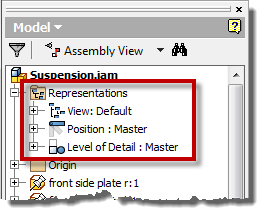How and When to use Autodesk Inventor Level of Detail Representations to create large Assembly drawings.
If you need to create drawings from your large Assembly files, you might appreciate this tip on using Inventor LOD’s or ‘Level of Detail’ Representations.
In the Joinery Industry we create all our drawings from our Assembly models. We provide part numbers on the drawings and a cutting ticket for the Workshop. We don’t create ‘Piece Part’ drawings – One timber rail is pretty much the same as another!
Occasionally Inventor can really struggle to create drawings from the Large assembly files that we work on. I want to show you how we use LOD’s to lighten the load on Inventor. I also want to show you when not to use LOD’s.
What are Assembly Representations?
Inventor’s Assembly representations can be found under the ‘Representations’ Node in the Assembly Browser.

You will see ‘View’, ‘Level of Detail’ and ‘Position’ nodes. We aren’t going to talk about Positional Representations today.
The key difference between a View Representation and a Level of Detail Representation is that a View will only change to ‘Look’ of something.
Level of Detail Rep’s use suppression to unload components from memory.
How do I create an LOD Rep’
Creating a new Level of Detail is easy. Simply right click on the ‘Level of Detail’ node in the Assembly browser and chose ‘New Level of Detail’.
Now go ahead and suppress any components that you won’t need in your drawing view (right click on a components and chose ‘Suppress’).

Tip: Remember to hit ‘Save’ to save your new LOD, with it’s suppression states.
You can use selection filters to quickly create LOD’s which suppress parts that aren’t needed in your drawing.
For example, you could suppress all the Internal components of your Assembly for a General Arrangement drawing, or Suppress all the parts that are too small to be seen at the Scale you will be working to.
Using LOD’s to create drawings
When you insert a base view into a drawing you will see your LOD’s listed. Select the LOD you want to use to create your drawing view from.

When NOT to use LOD’s
Every time a drawing references an LOD from an Assembly it is a separate call to the Assembly file.
So don’t reference two different LOD’s from the same Assembly into the same drawing.
You may end up with more parts being referenced into your Drawing file than were in your original Assembly!
How can that happen!
I’ve illustrated the point with the screen shots below.
For my test subject I’m using the ‘Suspension’ Assembly model from the Inventor samples, click on the images to enlarge.
Assembly Level of Detail Representations and loaded parts
The original suspension Assembly has 123 Occurrences of 56 open files.
I have created two ‘Level of Detail’ Representations:
‘External Components’ LOD – 91 open files, and 46 Occurrences
‘Wheel Section’ LOD – 45 open files, and 41 Occurrences
Assembly Level of Detail Representations and Drawing Views
These screen shots show the effect of using multiple LOD’s in a single drawing.
A drawing created from the original suspension Assembly has 123 Occurrences of 57 open files (the drawing files itself is an open file).
A drawing created from a combination of the ‘External Components’ LOD and the ‘Wheel Section’ LOD of the Suspension Assembly has 136 Occurrences of 49 open files.
That’s 13 More components in the Drawing than are in the Assembly!
Use only one LOD per Drawing
So the moral of today’s story is to use only one Level of Detail representation per drawing. If you want to quickly filter components off in your drawings, use an LOD rep in conjunction with View reps instead.
Why not simply reference the parts and sub Assemblies directly?
Referencing parts and sub Assemblies directly won’t allow you to create a coordinated BOM, parts list and part number Balloons…
Unless you use the technique described in this post!
Autodesk Inventor, Creating a coordinated BOM for Large Assemblies
[Edit] This behaviour has apparently been changed in Inventor 2012





I don’t know if you’ll see this since it’s been so long ago since you posted, but I have a question. Is there a way to get the iProperties of the assembly to change when the LoD changes? Based on the nature of the products my company makes, each assembly LoD requires a unique part number.
Hi Taylor,
Inventor LOD’s have now been replaced with model states – which make editing of iProperties per member much easier!
https://knowledge.autodesk.com/support/inventor/learn-explore/caas/CloudHelp/cloudhelp/2022/ENU/Inventor-Help/files/GUID-8E771DBE-1107-4AE8-BE3E-AF3A7977F3C6-htm.html
Thank you for this practical intel. Unfortunately I am using Inventer 2012 and will have to relearn the mindset. Great Stuff here!!!